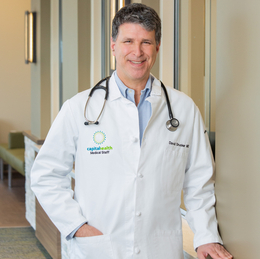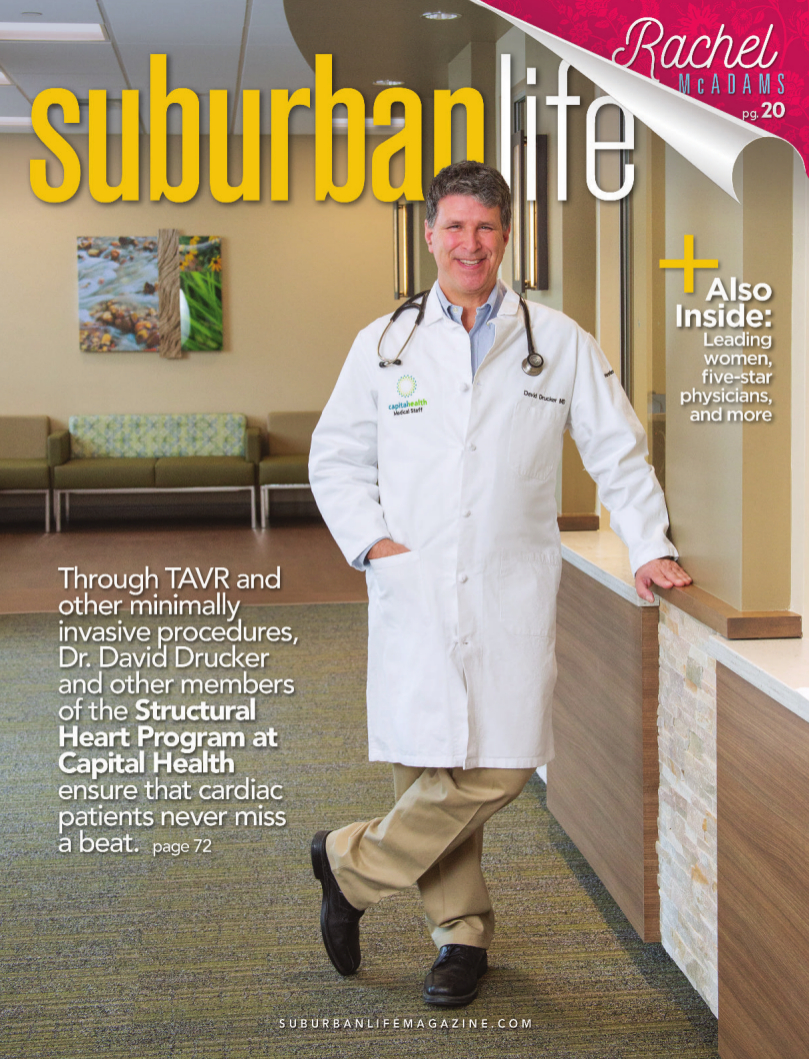
How to Mend a Broken Heart
Through TAVR and other minimally invasive procedures, the Structural Heart Program at Capital Health ensures that cardiac patients never miss a beat.
The human body is an astonishing work of art—a well-oiled machine built to endure, with an uncanny ability to bounce back after injury. It’s also surprisingly vulnerable.
“Over the past several decades, the average life expectancy for people in the U.S. has been going up and up,” says David W. Drucker, M.D., a physician with Capital Health. “The emergence of COVID set that back a bit, but the average American will live into their mid- to late 70s. That’s remarkable, but it also presents some challenges. People tend to have multiple medical problems as they get older, including problems associated with the heart.”
Dr. Drucker is the director of the Structural Heart Program at Capital Health Medical Center in Pennington, New Jersey, and the physician lead of Interventional Cardiology within Capital Health Medical Group. He sees patients at Capital Health locations in Newtown and across the river in Lawrenceville, New Jersey, many of whom are contending with symptoms that hinder their quality of life. For patients whose health has been affected by a condition known as severe aortic stenosis, he’s happy to tell them about an option called TAVR.
Short for transcatheter aortic valve replacement, TAVR is essentially a way to replace the aortic valve without open-heart surgery. This minimally invasive procedure is sometimes ideal for patients who have a narrowing of the aortic valve, typically due to the development of calcium deposits. The calcification forces the heart to work harder, resulting in symptoms such as lightheadedness, shortness of breath, and extreme tiredness even after a full night’s sleep.
“I did my training during the emergence of minimally invasive cardiac procedures, which really exploded in the mid-1990s,” Dr. Drucker says. “Procedures that involved balloons and stents became the routine. Those early procedures have paved the way for what we’re doing with the Structural Heart Program at Capital Health. TAVR has become a popular procedure for patients with structural heart disease.”
TAVR is usually performed via the femoral artery, with a catheter inserted through the skin or a small incision in the groin. Dr. Drucker and his team use X-ray guidance to deliver a new aortic valve through the catheter and precisely position it within the patient’s diseased valve, using a balloon to push the new “stent valve” against the calcium deposits and anchor the prosthesis in place. The release of calcified material from the patient’s native aortic valve is rare. To minimize the risk of a complication, Capital Health’s team may deploy a filter device called Sentinel to reduce the risk of peri-procedural stroke.
Once the procedure has been completed and the patient has recovered from anesthesia, hospital staff will have the patient up and walking around later that day. Most patients go home the day after surgery.
“A patient can have a new aortic valve in an hour to 90 minutes,” Dr. Drucker adds. “Their symptoms almost immediately get better.”
In 2012, when TAVR received FDA approval, the procedure was initially made available to inoperable patients, but it has since been approved for patients in all risk categories. That said, Dr. Drucker says some patients—depending on their age, anatomy, and other factors—may be better candidates for heart surgery.
“Back in the day, you would put a balloon in the valve—a valvuloplasty—but the effects didn’t last, and some people found themselves back in the same situation a few months later,” Dr. Drucker adds. “We rarely do that procedure as a standalone anymore; now it’s typically done with TAVR. We’ve done [TAVR] for patients in their 90s, and even one patient who was 101. It’s amazing how well people tolerate it.”
At Capital Health, patients who are considered good candidates for TAVR benefit from a team approach. A nurse practitioner with Capital Health’s Structural Heart Program guides the patient through every step of the process, from organizing office visits, to facilitating noninvasive tests, to working with the family perioperatively. An interventional cardiologist such as Dr. Drucker will perform the surgery, though a cardiothoracic surgeon will also be on hand in the event of a complication or if a surgical approach becomes necessary.
“As a team, we do a comprehensive evaluation and review all the available data to come up with the best recommendation in terms of risks and results,” he adds. “It’s not an independent, one-physician procedure. The whole team works together.”
Capital Health’s Structural Heart Program performed its first TAVR procedure earlier this year—on Valentine’s Day, to be precise. As of early May, Dr. Drucker had at least 15 more patients being evaluated for the procedure.
TAVR is one of several revolutionary procedures offered through Capital Health’s Structural Heart Program. Other minimally invasive options include those to help patients who suffer from atrial septal defects and patent foramen ovale, a hole in the heart between the upper heart chambers that did not close as it should have after birth. Also, the program offers WATCHMAN, which is a minimally invasive procedure to address stroke risk in patients with atrial fibrillation who are poor candidates for standard anti-coagulation. This form of cardiac arrhythmia can lead to blood clots and stroke originating in the left atrial appendage. By occluding this part of the heart, the device reduces the risk of stroke in a manner similar to an anticoagulant such as warfarin.
“It’s a very exciting time to work in interventional cardiology,” Dr. Drucker says. “If you had told me in 1995, when I was in training, that we would be doing the kinds of things we’re doing now, I probably wouldn’t have believed you.”
About Dr. Drucker
Dr. Drucker traces his decision to pursue a career in medicine to personal experiences from his time growing up in New York.
Dr. Drucker traces his decision to pursue a career in medicine to personal experiences from his time growing up in New York.
“My father was ill when I was young, so I was around doctors and medical professionals at an early age,” he recalls. “From everything my father went through, I was compelled to go into medicine. I wanted to provide compassionate care to people who needed it most.”
He went on to earn his medical degree at Washington University School of Medicine in St. Louis, and later completed his cardiovascular fellowship and echocardiography and interventional fellowship at Yale-New Haven Hospital in New Haven, Connecticut, where he also did his Internal Medicine residency. He became certified in interventional cardiology in 1999, and received his most recent recertification in 2019.
Dr. Drucker moved to Bucks County in 1999 to be closer to his family in New York and New Jersey. Today, as an interventional cardiologist with Capital Health, he specializes in minimally invasive procedures designed to improve patients’ heart function and, in the process, restore their quality of life. Dr. Drucker lives in Bucks County with his wife and son.
For more information about Capital Health’s Structural Heart Program, including details about its office locations and services offered, visit www.capitalhealthcardiology.org.
Photo by Alison Dunlap
Published (and copyrighted) in Suburban Life magazine, May 2023.



